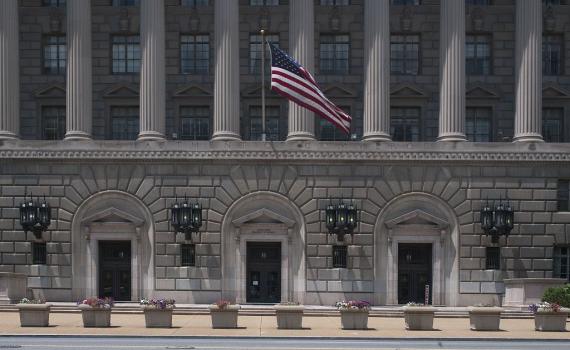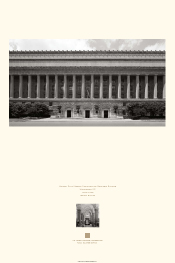Location: 1401 Constitution Ave. NW, Washington, DC 20230
History
Created in 1903, the Department of Commerce and Labor was one of the largest and most complex federal entities of its time, with multiple bureaus dedicated to economic and job development. In his last day in office on March 4, 1913, President Howard Taft split the departments, creating the Department of Commerce as it presently exists, which is headquartered in the Herbert Clark Hoover Department of Commerce Building.
The building is located within the Federal Triangle: a dense seventy-acre enclave of monumental federal buildings. The Federal Triangle exists on land allocated for government use as part of the 1902 McMillan Plan, which amplified Pierre Charles L’Enfant’s unfinished District of Columbia master plan. The McMillan Plan applied late-nineteenth century City Beautiful planning concepts. These advocated the orderly integration of landscape design, public art, and classically inspired Beaux-Arts architecture, in part to inspire civic virtue in the populace.
During the 1920s the Department of Commerce grew massively under Secretary of Commerce Herbert Hoover. By 1926 the department’s numerous bureaus were scattered about the city in ten separate buildings. Using the same trowel that George Washington used to lay the U.S. Capitol’s cornerstone, Herbert Hoover, then president, laid the building’s cornerstone on June 10, 1929. The building was completed in 1932. The New York architectural firm of York and Sawyer designed the building, with Louis Ayres as principal architect. However, the Commission of Fine Arts, the Public Buildings Program, and Hoover himself all had input informing the building’s design and location. Noted artist James Earle Fraser sculpted the various reliefs and figures upon the building.
Since its opening, the building has housed every secretary of Commerce in its fifth floor executive suite. In 1981 the building was renamed the Herbert Clark Hoover Department of Commerce Building. Since 1995 the White House Visitor’s Center has occupied the former Patent Search room in the north wing. The National Aquarium, originally a display space associated with the Bureau of Fisheries, has been housed in the basement since the building’s completion.
Architecture
The Herbert Clark Hoover Department of Commerce Building, with 3,300 rooms and over 1.8 million square feet of floor area, was the largest federal building in the country when it opened in 1932, and was proclaimed the largest office building in the world. The building demonstrates academically rigorous adherence to the Italian-inspired Second Renaissance Revival style with consistent cornice lines, strong horizontality, stone facing, colonnades and red tile roof.
The Public Buildings Act of 1926, which allocated $165 million for federal construction projects across the country, funded the Commerce Building’s construction. The eight-acre building is a large, steel-framed rectangular mass pierced by six landscaped internal courtyards for daylight and ventilation. The seven-story building has a tall attic story concealing the top two floors. Various textures of Indiana limestone are applied, with accent elements in different granites. Following Renaissance precepts, the large slabs of limestone on the lower two floors are rusticated, channeled, and chamfered while the upper stories are faced with smooth limestone.
Its east-facing, Fourteenth Street facade contains sixty-three bays divided into five portions with projecting sections at the ends and the center. The center section contains a dramatic Doric colonnade of twenty-four fluted columns, each forty-two feet tall, comprising the third through fifth floors. This section also contains the major pedestrian entrances, and its roof-line is crowned with a repeating series of alternating carved eagles and torches. The facade’s two receding portions contain three large twenty-one-foot-tall arched driveway portals accentuated by massive voussoirs. Elaborately treated bronze doors are set into each portal. Similar portals are used for the three central pedestrian doors, inset with elaborate rectangular granite openings and triangular pediments atop carved corbels. Clusters of three large, bronze, octagonal lamps, each with an acanthus base, rope molding, and spiraletes flank these doors.
Adjacent to many of the entries are bas-relief panels depicting the Commerce Department’s numerous bureaus plus inscription panels with quotes pertaining to commerce. The shorter north and south elevations feature additional colonnades. In contrast to the east facade, the rear, Fifteenth Street elevation is a monolithic plane broken by four projecting three-bay-wide pedimented colonnades. Their tympanums contain figural sculptures depicting Fisheries, Aeronautics, Mining, and Foreign and Domestic Commerce.
The interior contains monumental lobbies with corridors over a thousand feet long, sixteen major staircases and thirty-six elevators. The bulk of the building is devoted to offices, whose relative ease of reconfiguration was incorporated in the earliest designs to anticipate changing federal needs.
An imposing public space, the Fourteenth Street lobby is divided into central and flanking sections with bays of engaged Doric columns alternating with tall arched openings. Its ceilings are either groin vaulted or of hung plaster with decorative gold-painted Italian Renaissance coffering with polychrome glazing. The Levanto marble and Travertine floor contains mosaic borders of several other marbles and the walls are of golden Mankato stone. Other principal public spaces include the two-story tall Malcolm Baldridge Great Hall, formerly the Patent Search Room, featuring limestone walls and piers, Italianate bronze chandeliers and cork floors befitting the acoustics of the room’s busy purpose.
An eight-phase systems renovation began in November 2007 and will be completed in 2021. The Herbert Clark Hoover Department of Commerce Building is a contributing resource to the Pennsylvania Avenue Historic Site, originally designated in 1965. The following year the Pennsylvania Avenue Historic site, including the building, became a National Historic Landmark District.
Significant Events
- 1903: President Theodore Roosevelt establishes Department of Labor and Commerce
- 1913: Commerce becomes its own department, separate from Labor Department
- 1929-1932: Building constructed
- 1965: Secretary of the Interior designates the Pennsylvania Avenue National Historic Site
- October 15, 1966: National Historic Preservation Act passed and Pennsylvania Avenue National Historic Site, including Commerce building, becomes National Historic Landmark District
- 1981: Building renamed Herbert Clark Hoover Department of Commerce Building
- 1995: The White House Visitor Center opens in the renovated and restored Malcolm Baldridge Great Hall
Facts
- Architect: York & Sawyer
- Architectural Style: Second Renaissance Revival
- Construction Dates: 1929-1932
- GSA Building Number: DC0013ZZ
- Landmark Status: National Historic Landmark
- Primary Materials: Indiana limestone
- Prominent Features: Massive scale; Doric colonnade and porticos; Gable roof clad in red clay tiles; Patent Search Room with limestone finishes; Sculpture and relief panels by James Earle Fraser
Poster Download
Download the poster [PDF - 267 KB]

 U.S. General Services Administration
U.S. General Services Administration

